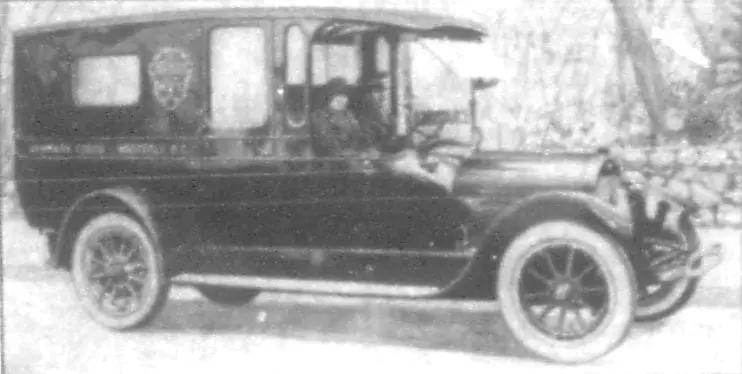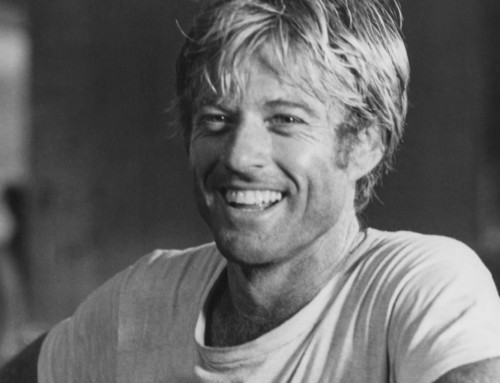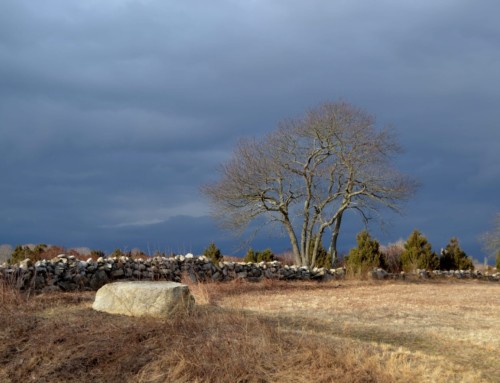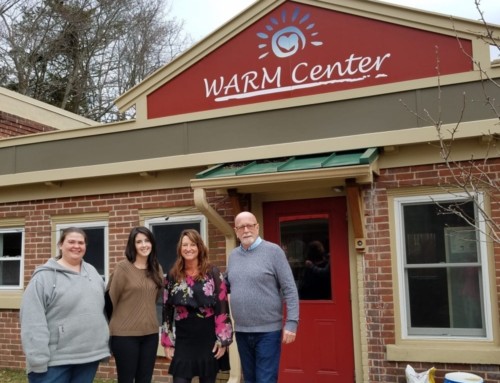For more than 100 years, the Westerly Ambulance Corps has been valiantly serving the community in its times of greatest need, and today, we celebrate a century of history for one of the town’s most essential organizations.
On July 26, 1917, the Westerly Red Cross Sanitary Corps was formed as a “detachment for war work.” At the founding meeting, the following individuals were selected: Thomas Perry, president, Dr. Frank I. Payne, Medical Director, and Timothy O’Connors of Barbour’s Pharmacy, Pharmaceutical Director.
It was also decided at this time that a course of study to join the Corps would be developed which would take eighteen months to complete.[1] In forming an organization, the Sanitary Corps of Westerly became the first such group in the State of Rhode Island.[2] In December 1917, the Sanitary Corps was summoned to Boston where they would await a call to provide aid after the infamous Halifax Explosion which claimed the lives of 2,000 individuals.[3] 24 members of the Sanitary Corps traveled to Boston, however, they were never requested to provide aid.[4]
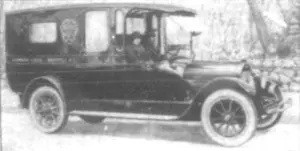
That same year, funds were raised to purchase an automobile ambulance which took patients to Wakefield, as Westerly did not have a hospital at the time.[7] Prior to the construction of Westerly Hospital in 1925, the Sanitary Corps took patients to New London, New Haven, Providence, and Boston. In the 1920’s, roads were not nearly as comprehensive and direct as they were in later decades, and as a result, it took six hours to get from Westerly to Boston.[8]
For several years in the Ambulance Corps’ infancy, they were granted use of the State Armory in Westerly for meetings, drills, and lectures. In February 1920, however, they were informed by the Quartermaster General that they were to vacate the space by April 1, forcing the organization to seek a new home.[9]
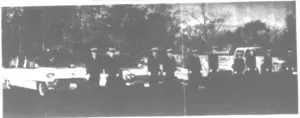
Throughout their early years, Dr. Payne was a consistent presence and he served as a mentor and guide to those who joined the Corps. In 1926, at the fourth annual Sanitary Corps Dinner, the group provided a testimonial to the dedication and hard work of Payne, who had been ill for several months. According to their speech, Payne was “the founder and organizer of the Westerly Sanitary Corps, instituted August 1917, [and] he has constantly been its leading spirit, guide, and adviser.”[13]
By the 1930’s, the Corps was soliciting donations on a yearly basis by collecting membership dues. These membership drives were promoted locally through the Westerly Sun which ran endorsements by members, including one piece in 1931, in which a man explains how his membership fee of $2.50 ultimately saved his family $307.[14]
The price of subscription service remained low for many years, only being raised to $3 in 1959. By 1992, the fee was $25 per year.[15] In the early 1930’s, the Sanitary Corps was headquartered in the Clyde Mills until 1934, when they opened new rooms in the Price Building on Main Street.[16]
The work of the Westerly Sanitary Corps was incomparable in September 1938, when Westerly was struck by a hurricane, the single greatest crisis to hit the town. In the aftermath of the hurricane, the Westerly Sun lauded the efforts of the Sanitary Corps’ workers, noting that they “rendered invaluable humanitarian service in Westerly and vicinity” and claimed that “many members remained on duty for hours without sleep or rest.”[17]
In 1938, the Corps had two ambulances in its service, and in the days after the hurricane struck on September 21, one ambulance was used to provide first aid around the beaches and the other was used to render emergency services in all other stricken areas.[18] By the 1940’s, the ambulances in service with the Corps were replaced frequently, as older ambulances dropped in value as soon as newer models are introduced.
Despite the frequent need for replacement, Westerly taxpayers were never asked to fund these purchases, as was often the case across America. Instead, the Sanitary Corps would hold drives to help fund the ambulances. Having two ambulances in their fleet was viewed as a necessity for the Corps after the opening of Westerly Hospital in 1925.[19]
In August 1950, the Westerly Sanitary Corps was granted two buildings at the Westerly State Airport which were initially constructed in 1942 by the United States Navy and were returned to the State of Rhode Island in 1947. The Corps was permitted the use of these buildings as “an emergency hospital in times of disaster and for other purposes deemed essential to the public interests of said Corps.”[20]
Another caveat to this transfer was that the Corps may never sell the property to “any corporation, firm, or person.”[21] In October of that same year, the Sanitary Corps purchased a plot of land on Chestnut Street where their first headquarters were to be built.[22]
The 1950’s were productive for the Westerly Sanitary Corps, as it saw several major changes by the middle of the decade. In 1955, the Rescue Squad was formed, and soon thereafter became an essential branch of the Corps service.[23] During that year, the Chestnut Street headquarters were established, and would serve as the base of operations for the Corps for nearly 50 years.
On January 13, 1956, the Westerly Sanitary Corps officially adopted a revision to their charter which stated that after more than 38 years under the original name, they would henceforth be known as the Westerly Ambulance Corps Inc.[24] At the start of the 1960’s, the Corps fleet included two ambulances, a surf boat, a rescue jeep, and a fully-equipped rescue truck.[25]
In 1967, the Corps celebrated their 50th Anniversary, and in September of that year, they held several events including an old-timersrs’ night, a banquet for all active members, and an open house at their Chestnut Street building.[26] It was noted that in the organization’s first 50 years, they took more than 24,000 calls in Westerly and the surrounding communities.[27] In 1981, a garage was built to house the Corps’ three ambulances, three rescue trucks, and two boats.[28]
By the time of their 75th anniversary in 1992, the Corps’ received an average of 11 calls a day or about 3,800 per year. In 1991, they also expanded their capabilities by adding an advanced life support unit, allowing for even greater service.[29] The 75th anniversary was also celebrated in grand fashion, including a 300-participant parade, a demonstration of their LifeStar helicopter at St. Pius X school, and an open house.[30]
2002 was another banner year for the Corps, as they began operating out of a new headquarters on Chestnut Street, across the street from their former facility. The $2 million complex houses all of their equipment, vehicles, and dispatching facilities.[31] Throughout the last century, the Westerly Ambulance Corps has provided incredible service to the community, and has truly lived up to their mission statement:[32]
“The Westerly Ambulance Corps is committed to provide quality emergency medical and dispatch services through our compassionate and caring volunteers and employees to the community and surrounding areas. Our service-oriented professionals strive for excellence through training and education.
Our organization will continue its tradition of community service through public education, providing special event coverage and giving assistance to other emergency services when called upon. The Corps followed this vision since 1917 and will continue to assist those in need.”
[su_accordion class=””] [su_spoiler title=”Footnotes” open=”no” style=”default” icon=”plus” anchor=”” class=””]
[1] “Local Laconics” Norwich Morning Bulletin, 29 September 1917, pg. 7.
[2] “First in the Nation; Westerly Ambulance Corps is Planning to Celebrate Its 75th Birthday” Westerly Sun, 30 August 1992.
[3] “Local Laconics” Norwich Morning Bulletin, 10 December 1917, pg. 7 and “Local Laconics” Norwich Morning Bulletin, 11 March 1918, pg. 7.
[4] Westerly Ambulance Corps, About Us, History, http://www.westerlyambulance.org/content/history/.
[5] “Local Laconics” Norwich Morning Bulletin, 16 May 1918, pg. 7.
[6] Westerly Ambulance Corps, About Us, History, http://www.westerlyambulance.org/content/history/.
[7] “Westerly” Norwich Morning Bulletin, 20 October 1919, pg. 7.
[8] “First in the Nation; Westerly Ambulance Corps is Planning to Celebrate Its 75th Birthday” Westerly Sun, 30 August 1992.
[9] “Westerly Sanitary Corps Planning to Erect New Building” Westerly Sun, 10 February 1920.
[10] “Westerly” Norwich Morning Bulletin, 20 November 1920, pg. 9.
[11] Westerly Land Deeds, vol. 49, pg. pg. 69-70.
[12] Westerly Land Deeds, vol. 62, pg. 415-416.
[13] “Testimonial to Dr. F.I. Payne” Westerly Sun, 8 January 1926.
[14] “$2.50 Membership in Sanitary Corps Saves Local Family $307.” Westerly Sun, 31 December 1931.
[15] “First in the Nation; Westerly Ambulance Corps is Planning to Celebrate Its 75th Birthday” Westerly Sun, 30 August 1992.
[16] “Sanitary Corps to Open New Rooms This Evening” Westerly Sun, 14 December 1934.
[17] “Sanitary Corps Rendered Heroic Service at Time of Hurricane” Westerly Sun, 10 October 1938.
[18] “Sanitary Corps Rendered Heroic Service at Time of Hurricane” Westerly Sun, 10 October 1938.
[19] “The Sanitary Corps” Westerly Sun, 1 March 1940.
[20] Westerly Land Deeds, vol. 69, pg. 37-38.
[21] Westerly Land Deeds, vol. 69, pg. 37-38.
[22] Westerly Land Deeds, vol. 69, pg. 190.
[23] Westerly Ambulance Corps, About Us, History, http://www.westerlyambulance.org/content/history/.
[24] “New Name is Adopted by Local Unit” Westerly Sun, 15 January 1956.
[25] “Rolling Equipment” Westerly Sun, 16 November 1960, pg. 11.
[26] “Ambulance Corps Notes 50th Anniversary” Westerly Sun, 23 August 1967.
[27] “Ambulance Corps Notes 50th Anniversary” Westerly Sun, 23 August 1967.
[28] “First in the Nation; Westerly Ambulance Corps is Planning to Celebrate Its 75th Birthday” Westerly Sun, 30 August 1992.
[29] “First in the Nation; Westerly Ambulance Corps is Planning to Celebrate Its 75th Birthday” Westerly Sun, 30 August 1992.
[30] “First in the Nation; Westerly Ambulance Corps is Planning to Celebrate Its 75th Birthday” Westerly Sun, 30 August 1992.
[31] Westerly Ambulance Corps, About Us, History, http://www.westerlyambulance.org/content/history/.
[32] Westerly Ambulance Corps, About Us, History, http://www.westerlyambulance.org/content/history/.
[/su_spoiler] [/su_accordion]
